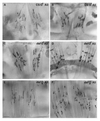dissatisfaction, a gene involved in sex-specific behavior and neural development of Drosophila melanogaster
- PMID: 9023356
- PMCID: PMC19613
- DOI: 10.1073/pnas.94.3.913
dissatisfaction, a gene involved in sex-specific behavior and neural development of Drosophila melanogaster
Abstract
Few mutations link well defined behaviors with individual neurons and the activity of specific genes. In Drosophila, recent evidence indicates the presence of a doublesex-independent pathway controlling sexual behavior and neuronal differentiation. We have identified a gene, dissatisfaction (dsf), that affects sex-specific courtship behaviors and neural differentiation in both sexes without an associated general behavioral debilitation. Male and female mutant animals exhibit abnormalities in courtship behaviors, suggesting a requirement for dsf in the brain. Virgin dsf females resist males during courtship and copulation and fail to lay mature eggs. dsf males actively court and attempt copulation with both mature males and females but are slow to copulate because of maladroit abdominal curling. Structural abnormalities in specific neurons indicate a role for dsf in the differentiation of sex-specific abdominal neurons. The egg-laying defect in females correlates with the absence of motor neuronal innervation on uterine muscles, and the reduced abdominal curling in males correlates with alteration in motor neuronal innervation of male ventral abdominal muscles. Epistasis experiments show that dsf acts in a tra-dependent and dsx-independent manner, placing dsf in the dsx-independent portion of the sex determination cascade.
Figures





References
Publication types
MeSH terms
Substances
LinkOut - more resources
Full Text Sources
Other Literature Sources
Molecular Biology Databases

